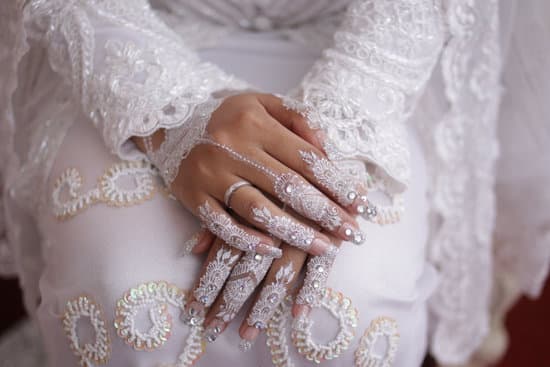When it comes to the important decision of purchasing wedding bands, many couples may find themselves wondering, “Who buys the wedding bands man or woman?” This age-old question speaks to the traditions and cultural expectations surrounding marriage and the exchange of rings as a symbol of commitment.
In this article, we will explore the origins of the tradition, changing views on gender roles, cultural influences, financial considerations, personal preferences, dispelling myths, practical tips for decision-making, and the significance of wedding bands.
The tradition of exchanging wedding bands dates back centuries and is deeply rooted in symbolism and ceremony. Historically, the practice has been associated with specific gender roles and societal expectations. However, as society evolves and perspectives shift, so too have opinions on who should be responsible for purchasing these cherished symbols of love and partnership.
In today’s world, modern trends have played a significant role in challenging traditional views on who buys the wedding bands. Couples are now navigating this decision-making process in new ways that reflect their personal beliefs and preferences.
Additionally, cultural influences around the world have shaped diverse practices when it comes to acquiring wedding bands for a marriage ceremony. It is essential to consider various factors such as financial considerations in budgeting for wedding bands while also valuing open communication and mutual decision-making between partners.
Historical Perspective
The tradition of exchanging wedding bands dates back to ancient Egypt and Rome, where the circular shape of the ring symbolized eternity and never-ending love. Historically, it was customary for the groom to present a wedding band to his bride as a symbol of his commitment and ownership. This practice reflected the traditional gender roles and power dynamics prevalent in those societies.
The Role of Gender Roles
In many historical cultures, marriage was often seen as a transaction between families, and the exchange of rings symbolized the transfer of ownership from the bride’s family to the groom. This perpetuated the idea that men were responsible for financially providing for their wives and making important decisions on behalf of the family. The purchasing of wedding bands by men reinforced these patriarchal norms.
Changing Perspectives
In recent years, there has been a shift away from traditional gender roles and expectations in relationships. With more focus on equality and partnership in marriages, modern couples are rethinking who buys the wedding bands. Many couples now choose to purchase their rings together or take turns paying for each other’s bands, reflecting a more egalitarian approach to marriage and financial responsibilities. This change is indicative of broader societal shifts towards gender equality in relationships and marriage.
Modern Trends
In modern times, the tradition of who buys the wedding bands has evolved significantly. While historically it was often the responsibility of the man to purchase both the engagement ring and wedding bands, today, there is a shift towards more egalitarian views on this matter. Many couples now choose to shop for wedding bands together and often split the cost equally. This reflects a broader societal move towards gender equality and shared decision making within relationships.
According to a survey conducted by The Knot, 45% of couples said they shopped for their wedding bands together, while another 32% said they discussed their preferences before making a decision. This indicates that more and more couples are moving away from traditional roles and are actively participating in choosing and purchasing their wedding bands as a team.
Furthermore, financial considerations also play a significant role in this changing trend. With many couples juggling various financial responsibilities in their lives, splitting the cost of wedding bands can be an attractive option. This approach allows both partners to have input into selecting rings that fit their style preferences while also being mindful of their budget.
| Survey Results | Percentage |
|---|---|
| Couples who shopped for wedding bands together | 45% |
| Couples who discussed preferences before making a decision | 32% |
Cultural Influences
Different cultures around the world have unique traditions and customs when it comes to wedding bands and the question of who buys them. In some cultures, it is customary for the groom’s family to purchase the wedding bands, while in others, the bride’s family takes on this responsibility. Additionally, there are cultures where both the bride and groom buy their own wedding bands as a symbol of independence and equality.
For example, in traditional Chinese culture, it is common for the groom’s family to provide the wedding bands as part of a larger set of dowry items. On the other hand, in Indian culture, the bride’s family traditionally provides gold jewelry, including the wedding bands, as part of the bride’s dowry. In Scandinavian countries like Norway and Sweden, it is common for both parties to exchange engagement rings and then purchase matching wedding bands together.
Understanding these cultural influences can provide valuable insight into how different societies view gender roles and financial responsibilities within marriage. It also highlights how diverse practices have evolved over time based on societal norms and historical customs.
These cultural differences can also influence modern couples’ decision-making processes when it comes to purchasing wedding bands.
While some may choose to adhere to their cultural traditions, others may opt for a more personalized approach that reflects their individual values and beliefs. Ultimately, understanding these diverse practices can help couples make informed decisions that align with their own cultural backgrounds or personal preferences when it comes to who buys the wedding bands.
Financial Considerations
When it comes to planning a wedding, there are many financial considerations to take into account, and the purchase of wedding bands is no exception. Traditionally, it has been the responsibility of the groom to purchase both the engagement ring and the wedding bands. However, modern times have seen a shift in this tradition, with many couples choosing to share the financial responsibility or splitting the cost of their wedding bands.
For those who are considering purchasing wedding bands together, it is important to establish a budget that works for both parties. This may involve open communication about each person’s financial situation and how much they are comfortable spending on their rings. Setting a budget can help alleviate any potential stress or conflict related to the financial aspect of purchasing wedding bands.
In some cases, cultural or religious traditions may also influence the decision-making process when it comes to budgeting for wedding bands. For example, in some cultures, it is customary for certain family members to contribute financially to the purchase of the wedding bands. Understanding and respecting these traditions can be an important factor in determining who buys the wedding bands and how they are paid for.
- Consider discussing your individual budgets beforehand
- Research different options within your price range
- Be open to compromise and finding a solution that works for both partners
Personal Preferences
When it comes to the decision of who buys the wedding bands, it is important for couples to communicate and make joint decisions. This is a significant purchase that symbolizes their commitment to each other, so both partners should be involved in the process. Here are some personal preferences to consider when making this decision:
- Open Communication: It is essential for couples to openly discuss their preferences and expectations regarding the purchase of wedding bands. They should talk about their budget, design preferences, and any cultural or family traditions that may influence their decision.
- Joint Decision Making: Both partners should be actively involved in the decision-making process. Whether they shop for the wedding bands together or discuss options separately before making a final choice, it should be a mutual decision that reflects both individuals’ styles and values.
- Respect Each Other’s Input: It’s important for couples to respect each other’s input and come to a compromise if they have different opinions on certain aspects of the wedding bands. This shows that they value each other’s perspectives and are willing to find a solution that makes them both happy.
Ultimately, when it comes to who buys the wedding bands between a man and a woman, it’s not about traditional gender roles but rather about the couple’s shared values and communication styles. By openly discussing their preferences, respecting each other’s input, and making joint decisions, couples can ensure that the process of buying wedding bands becomes a meaningful part of their journey towards marriage.
Busting Myths
Women Always Buy the Wedding Bands
There is a common misconception that women are always responsible for buying the wedding bands. This belief may stem from traditional gender roles and expectations. However, in modern times, this is no longer the case. Both partners contribute to the decision-making process and financial aspects of purchasing the wedding bands. It’s important to dispel this myth and recognize that the responsibility can be shared between the couple.
Men Should Always Foot the Bill
Another myth surrounding who buys the wedding bands is that men should always cover the cost. While this may have been true in the past, it’s no longer applicable to many couples today. With more emphasis on equality and shared responsibilities within a relationship, both partners may contribute financially to purchasing their wedding bands. This approach reflects a more modern and egalitarian view of marriage.
The Decision Reflects Gender Roles
Some may believe that whoever buys the wedding bands should conform to traditional gender roles. However, it’s crucial to understand that there are no strict guidelines dictating who should make this purchase based on gender. In today’s society, couples have varying dynamics when it comes to decision-making and financial matters, which can influence who ultimately buys the wedding bands.
Practical Tips
When it comes to deciding who buys the wedding bands, communication is key. It’s important for couples to openly discuss their preferences, expectations, and financial considerations when making this decision. One practical tip is to set a budget together for the wedding bands and decide how much each person is willing to contribute. This can help guide the decision-making process and ensure that both individuals are comfortable with the financial aspect.
Another practical tip is to consider shopping for wedding bands together. This allows both partners to have input on the style, design, and cost of the bands. It can also be a meaningful experience for couples as they choose something that symbolizes their commitment to each other. Additionally, some couples may opt for matching or complementary wedding bands, and shopping together can ensure that both individuals are happy with the final choice.
Finally, it’s important to remember that there are no hard and fast rules when it comes to who buys the wedding bands. Each couple’s situation is unique, and what works for one pair may not work for another. Ultimately, the decision should reflect the mutual agreement of both partners and be based on their individual circumstances.
| Practical Tips | Navigating Decision Making Process |
|---|---|
| Communication is key | Set a budget together |
| Shop for wedding bands together | Remember there are no hard & fast rules |
Conclusion
In conclusion, the significance of wedding bands goes beyond just being a symbol of love and commitment. It also reflects the unique dynamics and values of the couple who wears them. The decision of who buys the wedding bands can be influenced by tradition, financial considerations, personal preferences, and cultural influences. While there may have been historical gender roles associated with purchasing wedding bands, modern trends show a shift towards more equal decision making between partners.
One important aspect to consider when deciding who buys the wedding bands is financial considerations. Budgeting for the rings can be a practical challenge for many couples, and it’s important to have open and honest communication about expectations and limitations. Cultural influences also play a significant role in determining who takes on the responsibility of purchasing the wedding bands, and it’s interesting to see how different practices around the world shape this decision.
Ultimately, regardless of who physically buys the wedding bands, what truly matters is the mutual understanding and agreement between partners. Dispelling myths about traditional gender roles in purchasing wedding bands is essential in fostering healthy discussions and decision making within relationships. At the end of the day, what matters most is that both individuals feel comfortable with their choice and understand the symbolic meaning behind their wedding bands.

I have been involved in marriages for over 20 years helping couples and singles understand more about them.





